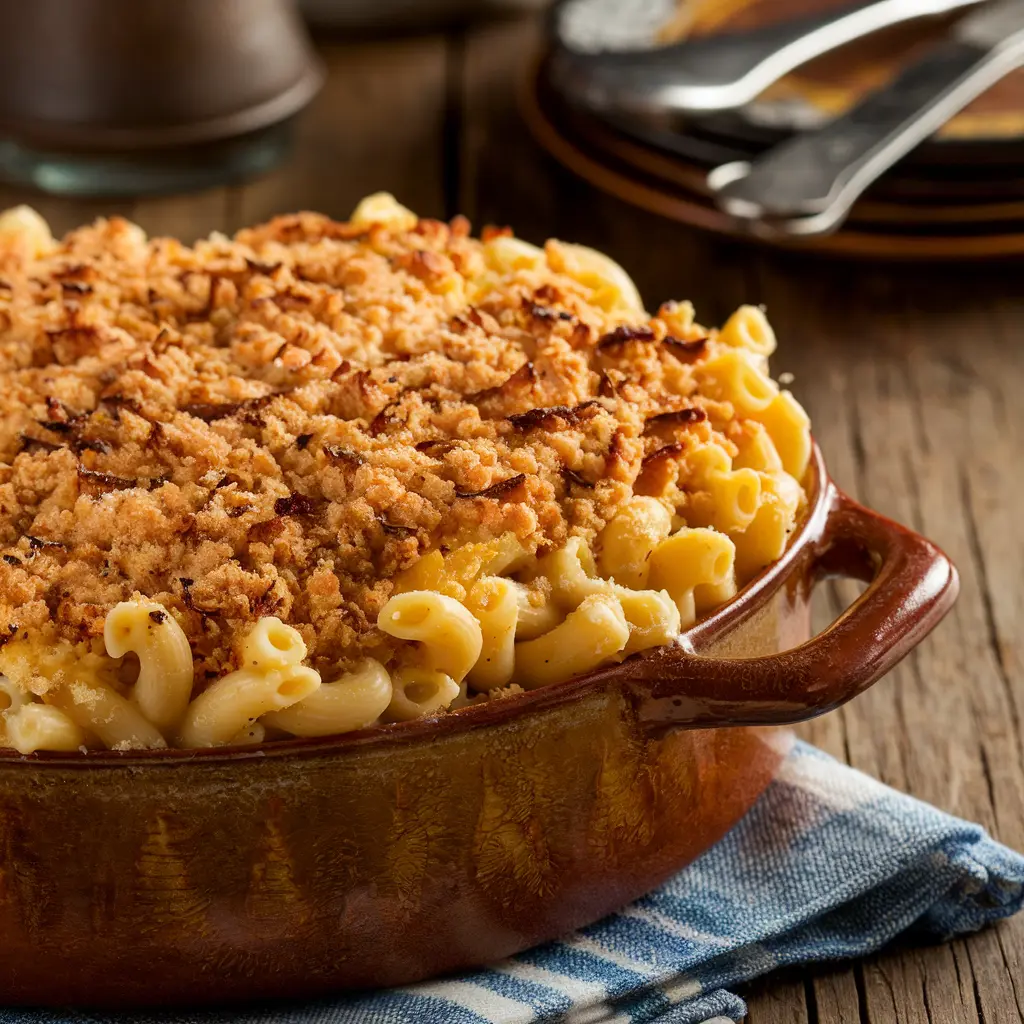Baked Mac and Cheese is a classic comfort food beloved for its creamy, cheesy texture and crispy golden topping. This dish has stood the test of time, earning its place on dinner tables, potlucks, and holiday feasts. But what makes baked mac and cheese truly special? This article dives deep into its history, ingredients, preparation techniques, and tips for achieving the perfect dish every time.
Table of contents
Ingredients Breakdown
Creating a delicious baked mac and cheese starts with choosing the right ingredients. Each component plays a crucial role in balancing flavors and achieving the perfect texture. Here’s a closer look at the essential ingredients and possible substitutions.
Core Ingredients
- Pasta:
- Type: Elbow macaroni is the traditional choice due to its small, tubular shape, which holds the cheese sauce well. Other suitable options include penne, rigatoni, and cavatappi.
- Tip: Cook the pasta until just al dente to avoid overcooking during baking.
- Cheese:
- Best Choices: A combination of cheeses provides a complex, rich flavor. Cheddar, mozzarella, gouda, and parmesan are popular. Sharp cheddar adds tanginess, while mozzarella ensures meltiness.
- Tip: Grate the cheese yourself for smoother melting, as pre-shredded cheese contains anti-caking agents.
- Milk and Cream:
- Why It’s Important: Whole milk and heavy cream create a rich, creamy sauce. For a lighter option, consider using half-and-half.
- Tip: Warm the milk before adding it to the roux for a smoother sauce.
- Butter:
- Role: Butter forms the base of the roux, which thickens the cheese sauce. Use unsalted butter to control the dish’s saltiness.
- Flour:
- Function: Flour is used to make the roux, helping the cheese sauce achieve its signature creamy texture.
- Seasonings:
- Essentials: Salt, black pepper, paprika, and mustard powder enhance the sauce’s depth of flavor. A pinch of cayenne pepper can add mild heat.
- Breadcrumbs (for Topping):
- Why It’s Important: Breadcrumbs create a crispy, golden topping that contrasts with the creamy interior. Panko breadcrumbs provide extra crunch.
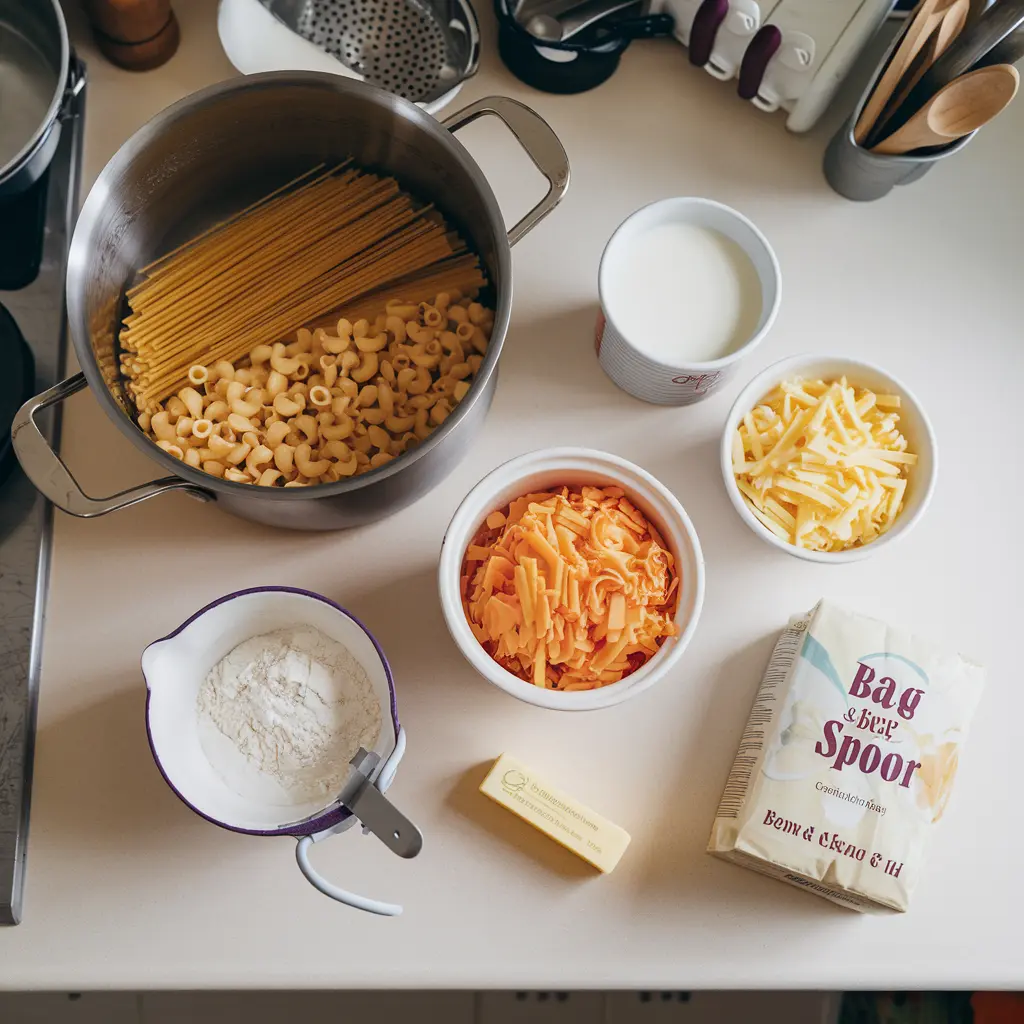
Ingredient Substitutions and Variations
- Pasta Alternatives: Gluten-free pasta for dietary needs.
- Cheese Swaps: Use vegan cheese for plant-based versions.
- Milk Substitutes: Almond or oat milk for lactose-free options.
- Healthier Options: Use whole wheat pasta, reduced-fat cheese, or skip the breadcrumb topping to cut calories.
By selecting quality ingredients and understanding how they work together, you can customize baked mac and cheese to suit any taste or dietary preference.
How to Make Baked Mac and Cheese
Crafting the perfect baked mac and cheese requires following key steps to ensure a creamy, flavorful dish with a crispy, golden topping. Here’s a detailed step-by-step guide for making this comfort food favorite.
Step-by-Step Guide
1- Gather Ingredients
Ensure all ingredients are pre-measured and ready. This includes pasta, cheeses, milk, butter, flour, seasonings, and breadcrumbs.
2- Cook the Pasta
- Bring a large pot of salted water to a boil.
- Add the pasta and cook until just al dente (slightly firm).
- Drain and rinse with cold water to stop cooking, then set aside.
3- Make the Cheese Sauce (Roux-Based)
- Create the Roux:
- In a large saucepan, melt the butter over medium heat.
- Whisk in the flour and cook for 2-3 minutes, stirring constantly, until the mixture turns golden.
- Add Milk and Cream:
- Gradually pour in warm milk while whisking continuously to prevent lumps.
- Simmer for about 5-7 minutes until the sauce thickens.
- Incorporate the Cheese:
- Remove from heat and slowly stir in shredded cheeses until fully melted and smooth.
- Add salt, pepper, paprika, and mustard powder to enhance the flavor.
4- Combine Pasta and Sauce
- Mix the cooked pasta into the cheese sauce, ensuring every piece is thoroughly coated.
Assembling and Baking
- Prepare the Baking Dish:
- Preheat the oven to 375°F (190°C).
- Lightly grease a baking dish with butter or cooking spray.
- Layer the Mac and Cheese:
- Pour the cheesy pasta mixture into the baking dish.
- Spread it evenly for consistent baking.
- Add the Topping:
- Mix breadcrumbs with melted butter and sprinkle evenly over the top.
- For extra cheesiness, add a sprinkle of parmesan or sharp cheddar.
- Bake the Dish:
- Place the dish in the preheated oven.
- Bake for 25-30 minutes or until the topping is golden brown and the sauce is bubbly.
Cooking Tips for Success
- Avoid Overcooking the Pasta: Slightly undercook it before baking to prevent mushiness.
- Cheese Selection: Use a blend of cheeses for maximum flavor and creaminess.
- Baking Temperature: Bake at 375°F for the perfect balance between crispy and creamy textures.
- Let It Rest: Allow the baked mac and cheese to rest for 5-10 minutes after baking to set the sauce.
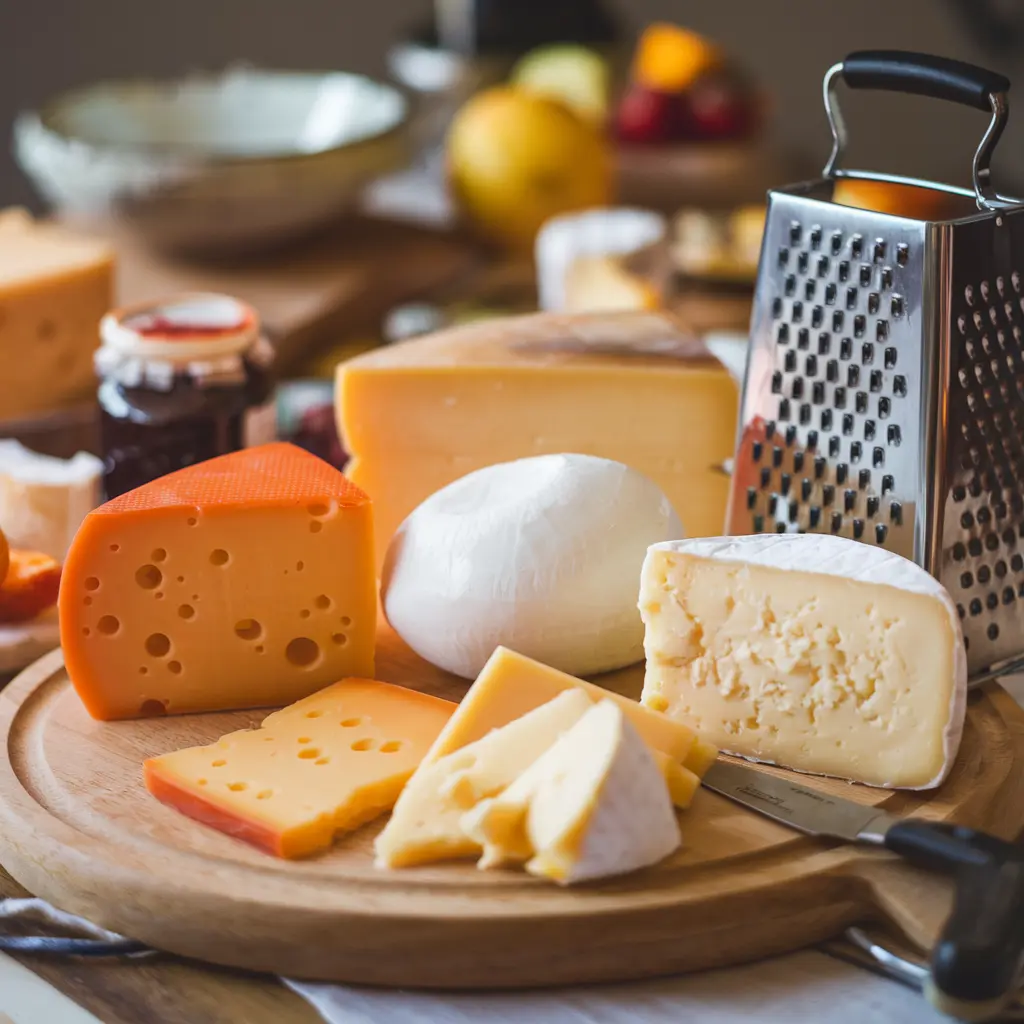
Variations and Customizations
One of the best aspects of baked mac and cheese is its versatility. You can customize the dish to suit different tastes, dietary needs, and special occasions. Here are some creative variations and customizations to elevate your mac and cheese game.
Classic Mac and Cheese
The classic version remains a timeless favorite. It includes:
- Cheese Mix: Sharp cheddar and mozzarella for creaminess.
- Seasoning: Simple salt, pepper, and paprika.
- Topping: A classic breadcrumb crust.
This version is straightforward, family-friendly, and perfect for gatherings.
Gourmet Versions
- Four-Cheese Mac and Cheese:
- Cheese Selection: Combine gruyère, gouda, parmesan, and white cheddar.
- Extras: Add a dash of truffle oil for an earthy, luxurious flavor.
- Lobster Mac and Cheese:
- Seafood Twist: Fold in cooked lobster chunks.
- Sauce Boost: Use a blend of sharp cheddar and Monterey Jack for a rich, creamy texture.
- Bacon and Jalapeño Mac and Cheese:
- Add-Ins: Crispy bacon bits and sliced jalapeños for smoky, spicy notes.
- Topping: Crushed tortilla chips for extra crunch.
Healthy and Diet-Friendly Options
- Vegan Mac and Cheese:
- Cheese Substitute: Use plant-based cheeses or make a creamy cashew sauce.
- Milk Alternative: Almond or oat milk works well.
- Topping: Use gluten-free breadcrumbs.
- Gluten-Free Mac and Cheese:
- Pasta Choice: Use gluten-free pasta.
- Thickener: Replace regular flour with cornstarch or gluten-free flour blends.
- Low-Calorie Mac and Cheese:
- Cheese Swap: Use reduced-fat cheeses like low-fat cheddar.
- Milk Choice: Use skim or almond milk.
- Add Vegetables: Mix in spinach, broccoli, or cauliflower to boost nutrients.
International Twists
- Italian-Style Mac and Cheese:
- Cheese Mix: Parmesan, ricotta, and mozzarella.
- Add-Ins: Sun-dried tomatoes and basil for a Mediterranean flair.
- Mexican Mac and Cheese:
- Cheese Blend: Cheddar, pepper jack, and queso fresco.
- Extras: Add black beans, corn, and taco-seasoned ground beef.
- French-Inspired Mac and Cheese:
- Cheese Mix: Brie, camembert, and gruyère.
- Finish: A sprinkle of herbes de Provence for elegance.
Customization Tips
- Mix and Match Cheeses: Blend cheeses with different textures and flavors.
- Add Protein: Chicken, pulled pork, or sausage can enhance the dish.
- Vegetable Boost: Add sautéed mushrooms, spinach, or roasted bell peppers.
- Flavor Enhancers: Try garlic powder, smoked paprika, or even nutmeg for depth.
Serving Suggestions
Baked mac and cheese is a versatile dish that pairs well with a variety of sides, beverages, and toppings. Whether served as a main course or a side dish, thoughtful pairings can elevate the dining experience. Here’s how to serve baked mac and cheese for maximum enjoyment.
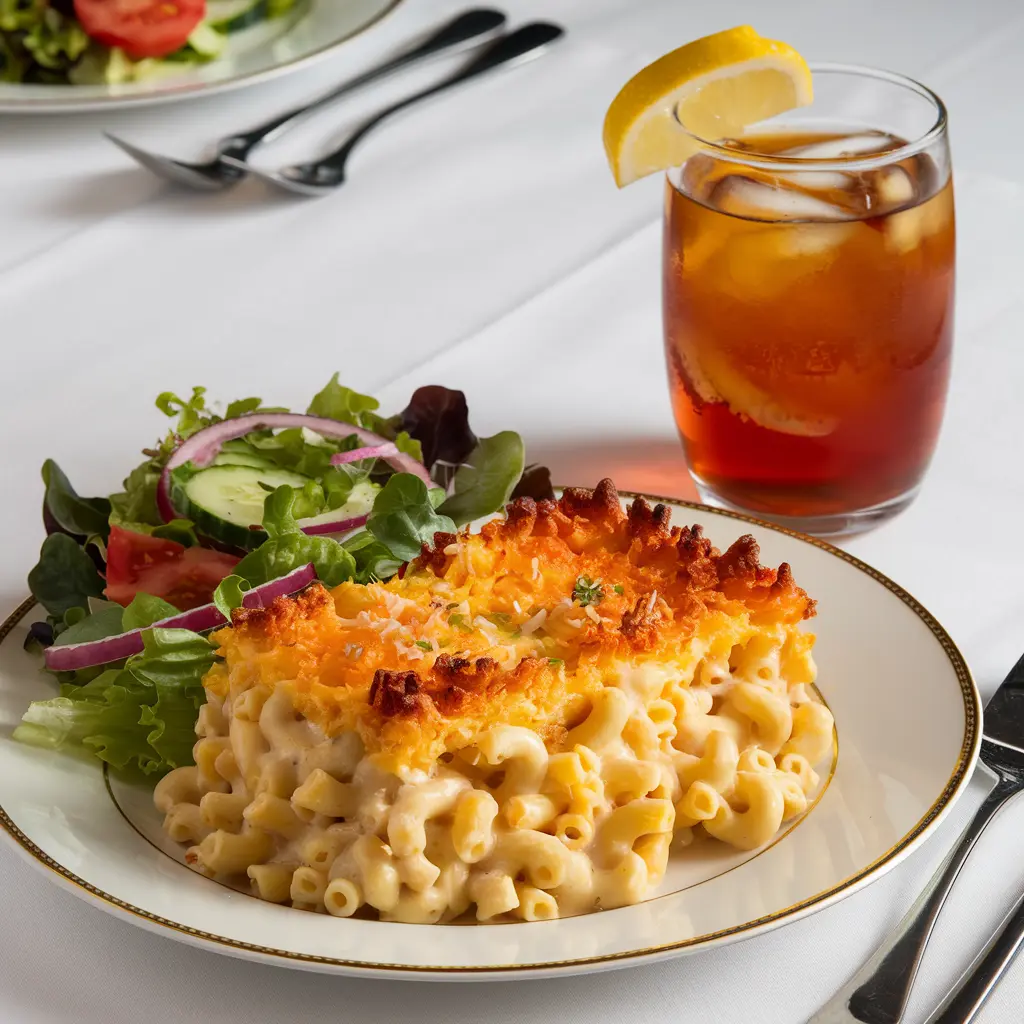
Best Side Dishes to Serve with Baked Mac and Cheese
- Salads:
- Garden Salad: A light, crisp garden salad with a tangy vinaigrette balances the dish’s richness.
- Caesar Salad: A classic Caesar with romaine lettuce, parmesan, and croutons adds crunch and freshness.
- Vegetables:
- Roasted Vegetables: Roasted broccoli, carrots, or Brussels sprouts provide earthy, caramelized flavors.
- Green Beans Almondine: Lightly sautéed green beans with almonds offer a nutty, fresh contrast.
- Breads:
- Garlic Bread: Warm, buttery garlic bread complements the creamy pasta.
- Dinner Rolls: Soft, fluffy rolls are perfect for soaking up the extra cheese sauce.
- Protein Pairings:
- Fried Chicken: Crispy fried chicken and baked mac and cheese are a classic soul-food combination.
- BBQ Ribs: Smoky, tangy BBQ ribs add a robust contrast.
- Grilled Sausages: Pairing with Italian or bratwurst sausages enhances savory notes.
Beverage Pairings
- Wines:
- White Wine: Chardonnay’s buttery and oaky notes match the creamy cheese sauce.
- Red Wine: A fruity Pinot Noir or light Merlot balances the dish’s richness.
- Beers:
- Lagers: Crisp lagers cleanse the palate.
- IPAs: Their hoppy bitterness cuts through the cheesiness.
- Non-Alcoholic Options:
- Iced Tea: Sweet tea or lemon iced tea refreshes the palate.
- Sparkling Water: Citrus-infused sparkling water adds a zesty twist.
Best Occasions to Serve Baked Mac and Cheese
- Family Dinners:
- Baked mac and cheese is a comforting weeknight meal that the whole family can enjoy.
- Holiday Gatherings:
- Thanksgiving, Christmas, and Easter dinners wouldn’t be complete without this beloved side dish.
- Potlucks and Parties:
- It’s a crowd-pleaser at potlucks, tailgates, and game-day parties.
- Special Events:
- Weddings, baby showers, and reunions often feature gourmet versions of mac and cheese as a unique side or main dish.
- Meal Prep and Leftovers:
- Make-ahead baked mac and cheese works well for meal prep or busy weeknights when time is limited.
Presentation Tips
- Serve in Individual Ramekins: For elegant dinner parties, bake and serve mac and cheese in personal ramekins.
- Garnish Ideas: Sprinkle fresh herbs like parsley or chives for color and freshness.
- Family-Style Serving: Use a decorative casserole dish for a rustic, inviting presentation.
Health and Nutritional Facts
Baked mac and cheese is undeniably delicious, but its nutritional profile can vary depending on the ingredients used. Understanding its calorie content, nutritional benefits, and healthier modifications can help you enjoy this comfort food while maintaining a balanced diet.
Nutritional Breakdown of Classic Baked Mac and Cheese
The nutritional content depends on portion size, ingredient quality, and preparation method. Here’s an overview based on a standard one-cup serving of classic baked mac and cheese:
- Calories: 300 – 450 kcal
- Carbohydrates: 30 – 40g
- Protein: 12 – 18g (from cheese and milk)
- Fat: 15 – 25g (saturated fat from cheese, butter, and cream)
- Fiber: 1 – 3g (depending on pasta type and added vegetables)
- Sodium: 500 – 800mg (from cheese and seasonings)
Key Nutritional Benefits
- Protein Source:
- Cheese and milk contribute to a high protein content, essential for muscle growth and repair.
- Calcium and Bone Health:
- Dairy ingredients are rich in calcium, supporting strong bones and teeth.
- Energy Boost:
- Carbohydrates from pasta provide energy, making this dish a satisfying meal option.
- Mood Enhancer:
- The creamy, cheesy texture offers comfort and emotional satisfaction, often linked to positive food memories.
Potential Health Concerns
- High Caloric Content:
- Traditional recipes are calorie-dense due to cheese, cream, and butter.
- Saturated Fat and Cholesterol:
- The dish contains significant amounts of saturated fat, which can impact heart health if consumed excessively.
- Sodium Levels:
- Many cheeses are high in sodium, potentially contributing to high blood pressure.
- Low Fiber:
- Classic versions may lack fiber unless vegetables or whole-grain pasta are added.
Health-Conscious Modifications
- Reduce Calories and Fat:
- Use reduced-fat cheese, skim milk, and less butter.
- Replace some cheese with nutritional yeast for added flavor and fewer calories.
- Boost Fiber and Nutrients:
- Choose whole-wheat or legume-based pasta.
- Add fiber-rich vegetables like spinach, broccoli, or cauliflower.
- Lower Sodium:
- Use low-sodium cheese and seasonings.
- Avoid adding extra salt during cooking.
- Make It Dairy-Free:
- Use plant-based cheeses and unsweetened almond or oat milk for a vegan version.
- Protein Boost:
- Add lean protein sources like grilled chicken, turkey sausage, or tofu.
Portion Control and Mindful Eating
- Serve Smaller Portions: Use portion-controlled ramekins or small bowls.
- Pair with Healthy Sides: Balance the meal with a fresh salad or steamed veggies.
- Enjoy Occasionally: Treat baked mac and cheese as an occasional indulgence rather than a daily meal.
Global Mac and Cheese Variations
Mac and cheese may have originated in Europe, but its popularity has spread worldwide, inspiring unique variations in different cultures. These international twists add exciting flavors and ingredients, transforming the classic comfort dish into something entirely new.
North American Variations
- Southern-Style Mac and Cheese (USA):
- Features: Extra cheesy with sharp cheddar, often baked with a crispy breadcrumb topping.
- Twist: Some recipes include eggs for a firmer, custard-like texture.
- Canadian Lobster Mac and Cheese:
- Features: Rich and creamy with chunks of fresh lobster.
- Twist: Often served in upscale restaurants as a luxurious entrée.
European Twists
- Italian Mac and Cheese:
- Features: A combination of parmesan, mozzarella, and ricotta cheeses.
- Twist: Enhanced with sun-dried tomatoes, basil, and sometimes prosciutto for a Mediterranean flavor.
- Swiss Älplermagronen:
- Features: A Swiss version of mac and cheese made with potatoes, pasta, and melted alpine cheese like Emmental.
- Twist: Traditionally served with caramelized onions and applesauce.
- British Cauliflower Cheese:
- Features: Similar to mac and cheese but with cauliflower replacing pasta.
- Twist: Often served as a Sunday roast side dish.
Latin American Variations
- Mexican Mac and Cheese:
- Features: Cheddar and pepper jack cheeses, spiced with jalapeños and cumin.
- Twist: Topped with crushed tortilla chips and served with a dollop of sour cream.
- Brazilian Macarrão de Forno:
- Features: A baked pasta dish mixed with ham, mozzarella, and tomato sauce.
- Twist: Often served as a special occasion meal.
Asian-Inspired Versions
- Japanese Mac and Cheese:
- Features: Incorporates miso paste for umami and cream cheese for extra richness.
- Twist: Topped with panko breadcrumbs and baked until crispy.
- Korean Kimchi Mac and Cheese:
- Features: Combines sharp cheeses with spicy, fermented kimchi.
- Twist: Topped with sesame seeds and scallions for added flavor.
African and Middle Eastern Mac and Cheese
- South African Macaroni and Cheese (Bobotie-Style):
- Features: A baked pasta dish similar to mac and cheese but with spiced ground meat and eggs.
- Twist: Topped with a custard-like layer and baked until golden.
- Middle Eastern Béchamel Pasta:
- Features: Similar to mac and cheese but layered with spiced ground beef and a rich béchamel sauce.
- Twist: Baked until golden brown, often served at family gatherings.
Unique Global Additions
- Truffle Oil (France): Adds a luxurious, earthy aroma.
- Goat Cheese (Spain): Used for a tangy, creamy flavor.
- Seafood (Portugal): Incorporates shrimp or cod for a coastal twist.
FAQs about Baked Mac and Cheese
Here are answers to some frequently asked questions about baked mac and cheese to help you master this classic comfort dish.
1. What Is the Best Cheese Combination for Baked Mac and Cheese?
Answer:
The best combination includes a mix of cheeses for both flavor and meltability. Sharp cheddar provides bold flavor, mozzarella ensures a creamy texture, and gruyère or parmesan adds depth and saltiness. Using at least two or three types of cheese enhances the dish.
2. How Can I Prevent My Baked Mac and Cheese from Drying Out?
Answer:
To prevent dryness:
- Use extra cheese sauce before baking.
- Add a splash of milk or cream if the sauce looks thick.
- Cover the dish with foil for the first half of baking to lock in moisture, then remove it for a crispy top.
3. Can I Make Baked Mac and Cheese Ahead of Time?
Answer:
Yes! Assemble the mac and cheese but don’t bake it. Cover tightly with plastic wrap and refrigerate for up to 24 hours. When ready to serve, bake at 375°F (190°C) for 30-35 minutes, adding 10 extra minutes if baking directly from the fridge.
4. Can Baked Mac and Cheese Be Frozen?
Answer:
Yes, baked mac and cheese can be frozen:
- Before Baking: Assemble the dish, cover tightly, and freeze for up to 3 months. Thaw in the fridge overnight before baking.
- After Baking: Let the dish cool completely, portion into airtight containers, and freeze for up to 2 months. Reheat in the oven at 350°F (175°C).
5. How Do I Keep Mac and Cheese Creamy When Reheating It?
Answer:
Reheat mac and cheese slowly:
- Add a splash of milk or cream to restore moisture.
- Reheat in the oven covered with foil at 350°F (175°C) for 20-25 minutes.
- For quicker reheating, use a microwave-safe dish, adding milk and covering with a damp paper towel. Heat in 1-minute intervals, stirring occasionally.
6. What Pasta Works Best for Baked Mac and Cheese?
Answer:
The best pasta types have ridges or hollow shapes to hold cheese sauce well:
- Elbow macaroni (classic choice)
- Cavatappi (spirals for extra sauce grip)
- Penne or rigatoni (tubular pasta for rich bites)
Avoid smooth pastas like spaghetti, as they don’t hold sauce effectively.
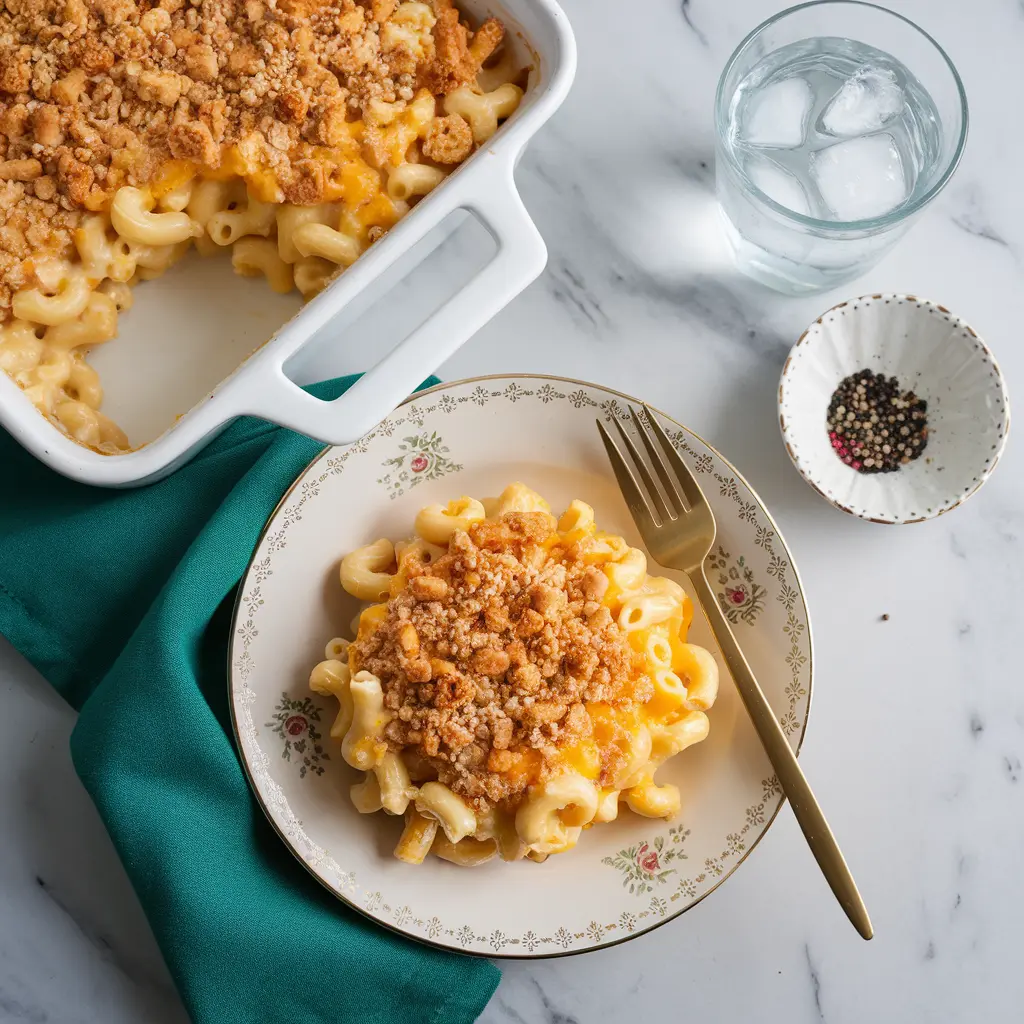
Conclusion
Baked mac and cheese is more than just a comfort food—it’s a timeless dish that brings people together with its creamy, cheesy goodness and satisfying crispy topping. Its versatility makes it perfect for casual family dinners, festive holiday feasts, and even upscale dining events.
By selecting the right cheeses, mastering the roux-based sauce, and using expert baking techniques, you can create a dish that’s flavorful and memorable. With endless customizations, from gourmet variations to healthier options, there’s a mac and cheese recipe for every taste and occasion.
Whether you’re new to cooking or a seasoned chef, baked mac and cheese is a classic worth mastering. With the tips, recipes, and variations shared in this guide, you can confidently prepare a dish that’s creamy, delicious, and always a crowd-pleaser.
Ready to try making your perfect baked mac and cheese? Gather your favorite cheeses, roll up your sleeves, and enjoy creating a dish that’s as comforting as it is delicious!
People Also Ask
1. What are the three best cheeses for mac and cheese baked?

